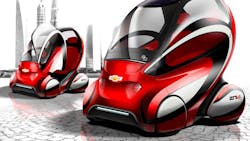General Motors China opened the second phase of the GM China Advanced Technical Center, a research complex for several GM technical development and design programs, including the China Science Lab, Vehicle Engineering Lab, Advanced Materials Lab, Advanced Powertrain Engineering Lab and Advanced Design Center. Reportedly it includes 62 test labs and nine research labs, and employs up to 250 engineers, designers, researchers, and technicians.
The ATC is GM’s center of activity for advanced vehicle design, powertrain and vehicle engineering, “telematics,” and general R&D. Their work involves product differentiation and competitiveness for that market, especially in fuel economy.
GM has 12 joint ventures in China, two wholly owned foreign enterprises and over 35,000 employees. In all, it sold more than 2.5 million vehicles there in 2011, and has long been the sales leader among foreign vehicle manufacturers in that market.
“The completion of the ATC is an important milestone for GM in China,” stated Bob Socia, president, GM China, and chief country operations officer for China, India and ASEAN. “It gives us the most comprehensive automotive technical center in our largest market. The center will serve not just China but also GM’s operations around the world.”
Jon Lauckner, GM’s chief technology officer, said the ATC’s R&D team is focusing on battery cells, lightweight materials, manufacturing processes, engines and transmissions, and developing mobile apps for connected urban driving.
GM China said it has had some “significant breakthroughs” in lightweight materials — the Micro-Foundry and Formability Lab that opened at ATC in September 2011, has made some developments in magnesium alloy low-pressure diecasting testing — and in batteries for electric vehicles. In August, it began fabricating and testing prototype battery cells and complete systems at the ATC.
GM said it is also making progress in “connected driving,” for example, a mobile app for that will allow EV drivers to monitor the battery’s charge and remaining available EV range from their smart phones, and also to set the vehicle’s charging schedule remotely.
In addition, engineers and technicians at ATC will test vehicle subsystems and components under varying conditions in dedicated labs for Concept Vehicle Integration, Structures and Chassis, Vehicle Assessment and Benchmarking, Electrical, HVAC (Heating, Ventilation and Air Conditioning), Materials and Fastening, and Powertrain.
At the ATC opening event, GM showed a life-size clay model of its EN-V 2.0, an electric vehicle design based on the EN-V concept introduced in 2010. The new model is the first electric vehicle developed by a joint venture in China, and GM will offer it for sale there next year.
The original EN-V (Electric Networked-Vehicle) was a two-seat electric vehicle designed to alleviate traffic congestion, parking availability, and air-quality issues. GM stated the concept “embodies” vision for sustainable urban mobility, and the EN-V 2.0 project is part of its overall vehicle electrification strategy in China.
“EN-V 2.0 is being developed and will be tested first right here in China,” according Socia. “This is a further testament to the important role that China is playing in GM’s product development strategy.”
About the Author
Robert Brooks
Content Director
Robert Brooks has been a business-to-business reporter, writer, editor, and columnist for more than 20 years, specializing in the primary metal and basic manufacturing industries.
